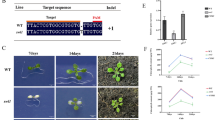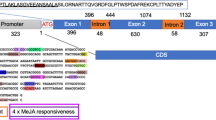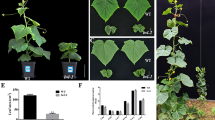Abstract
Pyruvate orthophosphate dikinase (PPDK) is a critical enzyme for C4 photosynthesis, providing the primary acceptor for fixation of bicarbonate in mesophyll cells. Although first isolated in C4 plants, it is also present in C3 species. We report that the single gene encoding PPDK in Arabidopsis thaliana possesses two promoters, giving rise to two types of transcript. The longer transcript is generated from a promoter upstream of the first exon, while the shorter transcript is derived from a promoter found within the first intron of the longer form. Apart from 5′ untranslated regions, the presence of the first exon, and three missing codons at the start of the second exon in the longer form, the transcripts are identical. Fusions between the two forms of transcript and gfp showed that the longer transcript encodes a protein targeted to the chloroplast, that its first exon acts as a transit peptide, and that the smaller protein is cytosolic. Abundance of the shorter transcript, responsible for producing the cytosolic protein increases rapidly and specifically during extended dark and dark-induced senescence. Transcripts for both chloroplastic and cytosolic proteins were detectable in cotyledons, while in cauline leaves the transcript encoding the chloroplastic protein was most abundant. We propose that in cotyledons PPDK may be important in supplying PEP to gluconeogenesis, and in ageing leaves it allows remobilisation of nitrogen to supply reproductive tissue.
Similar content being viewed by others
References
An Y-Q, McDowell JM, Huang S, McKinney EC, Chambliss S, Meagher RB (1996) Strong, constitutive expression of the Arabidopsis ACT2/ACT8 actin subclass in vegetative tissues. Plant J 10:107–121
Aoyagi K, Bassham JA (1983) Pyruvate orthophosphate dikinase in wheat leaves. Plant Physiol 73:853–854
Aoyagi K, Bassham JA (1984) Pyruvate orthophosphate dikinase of C3 seeds and leaves as compared to the enzyme from maize. Plant Physiol 75:387–392
Aoyagi K, Bassham JA (1985) Synthesis and uptake of cytoplasmically synthesised pyruvate orthophosphate dikinase by chloroplasts. Plant Physiol 78:807–811
Brown NJ, Parsley K, Hibberd JM (2005) The future of C4 research–maize, Flaveria or Cleome? Trends Plant Sci 10:215–221
Bruderer T, Wehrli C, Kohler P (1996) Cloning and characterisation of the gene encoding pyruvate phosphate dikinase from Giardia duodenalis. Mol Biochem Parasitol 77:225–233
Carroll LJ, Dunaway-Mariano D, Smith CM, Chollet R (1990) Determination of the catalytic pathway of C4-leaf pyruvate orthophosphate dikinase from maize. FEBS Lett 274:178–180
Chastain CJ, Chollet R (2003) Regulation of pyruvate orthophosphate dikinase by ADP-/Pi-dependent reversible phosphorylation in C3 and C4 plants. Plant Physiol Biochem 41:523–532
Cooper RA, Kornberg HL (1967) The direct synthesis of phosphoenolpyruvate from pyruvate by Escherichia coli. Proc R Soc Lond B Biol Sci 168:263–280
Emanuelsson O, Nielson H, von Heijne G (1999) ChloroP, a neural network-based method for predicting chloroplast transit peptides and their cleavage sites. Protein Sci 8:978–984
Emanuelsson O, Nielson H, Brunak S, von Heijne G (2000) Predicting subcellular localisation of proteins based on their N-terminal amino acid sequence. J Mol Biol 300:1005–1016
Glackin CA, Grula JW (1990) Organ specific transcripts of different size and abundance derive from the same pyruvate orthophosphate dikinase gene in maize. Proc Natl Acad Sci USA 87:3004–3008
Hatch MD (1987) C4 photosynthesis: a unique blend of modified biochemistry, anatomy and ultrastructure. Biochim Biophys Acta 895:81–106
Hatch MD, Slack CR (1968) A new enzyme for the interconversion of pyruvate and phosphopyruvate and its role in the C4 dicarboxylic acid pathway of photosynthesis. Biochem J 106:141–146
Herzberg O, Chen CC, Kapadia G, McGuire M, Carroll LJ, Noh SJ, Dunaway-Matiano D (1996) Swiveling-domain mechanism for enzymatic phosphotransfer between remote reaction sites. Proc Natl Acad Sci USA 93:2652–2657
Hibberd JM, Linley PJ, Khan MS, Gray JC (1998) Transient expression of green fluorescent protein in various plastid types following micro-projectile bombardment. Plant J 16:627–632
Hibberd JM, Quick WP (2002) Characteristics of C4 photosynthesis in stems and petioles of C3 flowering plants. Nature 415:451–454
Imaizumi N, Ku MS, Ishihara K, Samejima M, Kaneko S, Matsuoka M (1997) Characterisation of the gene for pyruvate orthophosphate dikinase from rice, a C3 plant, and a comparison of structure and expression between C3 and C4 genes for this protein. Plant Mol Biol 34:701–716
Kanai R, Edwards GE (1999) The biochemistry of C4 photosynthesis. In: Sage RF Monson RK (ed) C4 plant biology. Academic Press, San Diego, pp 49–87
Kang HG, Park S, Matsuoka M, An G (2005) White-core endosperm floury endosperm-4 in rice is generated by knockout mutations in the C4-type pyruvate orthophosphate dikinase gene (OsPPDKB). Plant J. 42:901–11
Leegood RC, Ap Rees T (1978) Phosphoenolpyruvate carboxykinase and gluconeogenesis in cotyledons of Cucurbito pepo. Biochimica et Biophysica Acta 524:208–218
Lin J-F, Wu S-H (2004) Molecular events in senescing Arabidopsis leaves. Plant J 39:612–628
Maruyama K, Sugano S (1994) Oligo-capping: a simple method to replace the cap structure of eukaryotic mRNAs with oligoribonucleotides. Gene 138:171–174
Matsuoka M, Ozeki Y, Yamamoto N, Hirano H, Kano-Murakami Y, Tanaka Y (1988) Primary structure of maize pyruvate orthophosphate dikinase as deduced from cDNA sequence. J Biol Chem 263:11080–11083
Matsuoka M, Numazawa T (1991) CIS-acting elements in the pyruvate orthophosphate dikinase gene from maize. Mol Gen Genet. 228:143–152
Moons A, Valcke R, Van Montagu M (1998) Low-oxygen stress and water deficit induce cytosolic pyruvate orthophosphate dikinase (PPDK) expression in roots of rice, a C3 plant. Plant J 15:89–98
Penfield S, Rylott EL, Gilday AD, Graham S, Larson TR, Graham IA (2004) Reserve mobilisation in the Arabidopsis endosperm fuels hypocotyl elongation in the dark, is independent of abscisic acid, and requires the PHOSPHOENOLPYRUVATE CARBOXYKINASE1 gene. Plant Cell 16:2705–2718
Pocalyko DJ, Carroll LJ, Martin BM, Babbit PC, Dunaway-Mariano D (1990) Analysis of sequence homologies in plant and bacterial pyruvate phosphate dikinase, enzyme I of the bacterial phosphoenolpyruvate: sugar phosphotransferase system and other PEP-utilising enzymes. Identification of potential catalytic and regulatory motifs. Biochemistry 29:10757–10765
Rosche E, Westhoff P (1995) Genomic structure and expression of the pyruvate, orthophosphate dikinase gene of the dicotyledonous C4 plant Flaveria trinervia (Asteraceae). Plant Mol Biol 29:663–678
Sambrook J, Fritsch EF, Maniatis T (1989) Molecular cloning: a laboratory manual. Cold Spring Harbor Laboratory Press, New York
Sheen J (1991) Molecular mechanisms underlying the differential expression of maize pyruvate, orthophosphate dikinase genes. Plant Cell 3:225–245
Simpson RH, Lambers H, Dalling MJ (1983) Nitrogen redistribution during grain growth in wheat (Triticum aestivum L.). Plant Physiol 71:7–14
Small I, Peeters N, Legeai F, Lurin C (2004) Predotar: A tool for rapidly screening proteomes for N-terminal targeting sequences. Proteomics 4:1581–1590
Stewart CR, Beevers H (1967) Gluconeogenesis from amino acids in germinating castor bean endosperm and its role in transport to the embryo. Plant Physiol 41:1587–1595
Streatfield SJ, Weber A, Kinsman EA, Häusler RE, Li J, Post-Beittenmiller D, Kaiser WM, Pyke KA, Flügge UI, Chory J (1999) The phosphoenolpyruvate/ phosphate translocator is required for phenolic metabolism, palisade cell development and plastid-dependent nuclear gene expression. Plant Cell 11:1609–1621
Voll L, Häusler RE, Hecker R, Weber A, Weissenböck G, Fiene G, Waffenschmidt S, Flügge UI (2003) The phenotype of the Arabidopsis cue1 mutant is not simply caused by a general restriction of the shikimate pathway. Plant J 36:301–317
Wood HG, O’Brien WE, Michaels G (1977) Properties of carboxytransphosphorylase; pyruvate, phosphate dikinase; pyrophosphate-phosphofructokinase and pyrophosphate-acetate kinase and their roles in the metabolism of inorganic pyrophosphate. Adv Enzymol 45:85–155
Acknowledgements
We thank Richard Leegood, John Gray, Chris Chastain and an anonymous referee for useful advice, and Susan Stanley, Naomi Brown, Elisabeth Truernit, Senthil Natesan, Christine Newell and Jesus Badillo Corona for help in the lab. We thank BBSRC for funding (P18931).
Author information
Authors and Affiliations
Corresponding author
Rights and permissions
About this article
Cite this article
Parsley, K., Hibberd, J.M. The Arabidopsis PPDK gene is transcribed from two promoters to produce differentially expressed transcripts responsible for cytosolic and plastidic proteins. Plant Mol Biol 62, 339–349 (2006). https://doi.org/10.1007/s11103-006-9023-0
Received:
Accepted:
Published:
Issue Date:
DOI: https://doi.org/10.1007/s11103-006-9023-0




